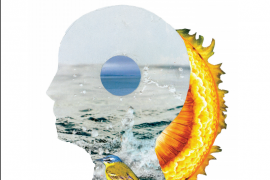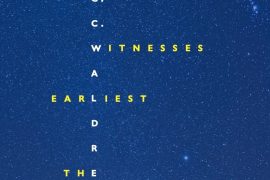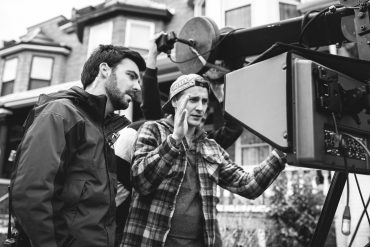Rachel Jamison Webster grew up in the small town of Madison, Ohio, on Lake Erie and now lives in Evanston, Illinois, where she teaches at Northwestern University and Directs the Creative Writing Program. She is the author of September: Poems, (Northwestern University Press 2013), The Endless Unbegun (a cross-genre book published by Twelve Winters Press in 2015), and a forthcoming memoir about caring for her partner as he suffered and died from ALS. We spoke with her around the 50th anniversary of Earth Day, when her book of collage and found poetry, The Sea Came Up & Drowned, was published by Raw Books Press.
ER: Did you have ways of observing Sabbath – or holy rest – before COVID? If so what practices have carried forward? What’s changed?
Rachel Jamison Webster: I meditate every morning and evening, in which I try to clear my own energy, connect to the earth and open myself to divine guidance. I often use this time to ask how I may be of service. But I have not been very good at keeping a Sabbath, because I get caught up in the busyness of our culture, and get very involved with what I am creating. I am very fortunate, because I am not doing very much in my life that I don’t believe in. But even things that are close to the heart—like writing, parenting, teaching, studying—can become too overscheduled, too associated with doing rather than being.
This time of social distancing has been restorative for me on a personal level. I could feel myself releasing some of the ambition and adrenaline—ego—energy that was running me without my realizing it. During this time, I have entered more deeply into a space of gratitude, humility and heartfelt connection to others. This time has also returned me to poetry—poems written from my own days—after many years of primarily writing essays and memoir. That space of poetry is a little more tender, wondering and humble for me. And it is very connected to the sacred.
I love thinking of this time of enforced social distancing as a cultural Sabbath. I think that helps to explain my experience of it. I also think that this time marks a great shift in our world. I sense that this is a period in which we should be allowing ourselves to rest and access stillness, meditation and prayer so that our future actions can come from a place of deep connectedness and love. These actions will be different than those driven by reaction, or motivated by the business, consumption and adrenaline that have been fueling our culture.
The concepts of “doing” and “non-doing” are very important in Eastern traditions. Tapping into meditation and “non-doing” allows us to clear cravings and attachment-based thinking. We have an opportunity to look at ourselves and see those blocks to stillness, love and Oneness within ourselves. Just by saying hello to those energies, they can clear, and then we can often feel a deeper stillness, and an intimation of an underlying harmony. This harmony, call it Oneness, or Love, is present in the world even in the throes of tragedy, or during a dramatic upheaval of death and rebirth, like our world is in now.
ER: How has this time affected your relationship with Earth?
RJW: The earth is the most restorative and buoying force for me. In my darkest hours, seeing blossoms or sunlight have functioned as a genuine lifeline for me, a promise of life and of renewal—and a source of uplift and joy. When someone is really seeking, feeling empty or grieving or needing to be filled, a different relationship opens up. The field of attention opens. This can happen with the spiritual text and it can happen with nature. We become open to the communication, the “isness” of nature, the life force, cycles and harmony, and what we encounter has a way of healing and teaching us.
But our spring here has been covered with snow too. Nature is not only creation, it is also destruction, and this is important. The destruction is necessary for the renewed creation, a creation that is even more embodied on earth. Easter comes after Good Friday, after terrible grieving, injustice and loss, and that makes the return that much wiser, that much more compassionate, that much more miraculous and involved in the ongoing world.
ER: Tell us about your current ecosystem. What are the land(and/or sea)scapes you’re often permitted to return to, a la Robert Duncan’s meadow?
RJW: I walk to Lake Michigan every day. It is still very cold here, so while I know that many people are getting through this time by seeing achingly glorious lilacs and cherry trees, we are still surrounded by tones of gray and just the shy beginnings of green. The lake is a different color every day and it is restorative for me to see those colors and to breathe the fresh air, alongside the sound of the waves, the lake that is also breathing. I think it is good for us humans to see something—often—that we cannot see the other side of, that our minds and organizational intelligence cannot pretend to contain or command. Lake Michigan is that for me.
This is not quite the lush, wild landscape I often dream of, but it is a public park, still open to walkers and cyclists, and so I also see many people—fireman checking the hydrants, letter carriers delivering mail, families walking with their children. Everyone is social distancing and wearing masks now but people are still smiling and saying hello to one another. So, this social ecology is also part of the nature that’s sustaining me right now.
ER: In Mary Is a River you inhabit the voice of Mary Magdalene in a book-length sequence. How did you find your way to her voice? Have you written in the voice of other Biblical figures? How did your time working on those poems affect or articulate your own faith? How would you talk about the ways you experience or practice faith now?
RJW: I was in a very intense meditation of purification. I had just been divorced and I felt guilt about that, grief and so much self-judgement. I wanted to heal and purify myself spiritually and so I was doing quite a lot of spiritual study. I had spent many years studying the yoga sutras and doing meditation and studying other Eastern texts, and so all those ideas were with me. And then I started writing in the voice of Eurydice, from Greek mythology. But then I had the important realization—or the guidance or the feeling—that those were all external to the tradition I was born into. I realized that I was going to have to grapple and meditate with the foundational story and spiritual tradition of my life, and the one which underlies most of our culture, which is that of Christianity. At that point, the meditation and writing took on its own life, and I felt like I was both inventing this book and hearing it being dictated to me. The process allowed me to lament the silencing of women in Christianity, particularly women who are priestesses, who have their own practice of spiritual study and teaching. There is a deep grief regarding the invisibility of the women. It also became a way for me to try to articulate the profound spiritual transformation of Love. And ultimately, it brought me back into relationship to Christianity, especially in its radically mystical, transformational heart.
Later, I learned, from the scholar Barbara Newman, who studies female medieval mystics, that this was once a common practice for nuns and sisters of the church—to imagine themselves in the Biblical stories and enact or rewrite them.
But I do not consider myself a Christian anymore, because I cannot see a place in the tradition for my full creative growth and sacred expression as a woman, and because I have been so disappointed by many of the ways I see Christianity being interpreted and expressed politically. With that said, I take Whitman’s phrase to heart, “argue not concerning God.” I think at its heart, Christianity is perhaps the most radical and transformational of traditions. It is of the heart, and extraordinary in its insistence that God suffers here, with us, in a way that is continuously transformational and participatory. I also know many people who are living the call as true Christians, giving beautifully, generously and radically, with a transformative sense of justice and care. This is a very elevated and intelligent calling, and I have deep respect for them and their acts.
What I have learned is that meditation and spirituality are central to my life. When I get too secular and intellectual, things shut down for me. But when my meditative practice is working—that is, when I am tapping into guidance and luminosity and clearing my own dross (lower, egoic energies) everything flows better. I know what I need to do that day to fulfill some sense of soulful expression and give to others. This is the dream and the best feeling to me—to participate in action and non-action in a way that stays connected to mystery, truth and enacted love. To be a vessel or channel for what is beyond me.
ER: I’m curious based on this new book, The Sea Came Up and Drowned, what do you think we can learn about the history of the earth through our study of past human cultures, and what do you think the stories are inside the sea, the land, biota?
RJW: This is an interesting set of questions. Thank you. I was a little surprised by the humanist bent these poems took, the fact that I was reading a text about the earth but seeing the humans that were missing from the story. What was missing, in particular, was a sacred relationship to the earth. An understanding of the earth that is deeply respectful and relational. The Western, colonizing mind understands the earth primarily as land to be farmed, developed or mined for natural resources. It is there to be used to make something else. That is not a sacred relationship, because it is a relationship of use rather than respect. But indigenous people have had an understanding of the earth as the sacred sustainer, as the source of mystery, power and value in her own right. Places are sacred simply because they are. Indigenous cultures have preserved this understanding against all odds—through colonization and genocide—and are sharing it more widely now. And so, it is a mistake to think that we are reinventing or resituating our relationship to the earth. We are just doing what we—meaning the colonizers, and the colonizing faith of Christianity—should have done all along—which is behold these other religions with deep humility and respect.
At the same time, we all have the opportunity—each one of us—to come into sacred relationship with the earth and her places. To know that the land and planet we inhabit is holy. This is what I think EcoTheo is doing well—inviting people into that intimacy, that complex and deeply personal relationship with the sacred and with nature.
ER: It seems to me there are similarities between the erasure/mining work of these poems and midrash – finding other texts within a text. How has this project affected your approach to reading? Thoughts on lectio divina?
RJW: I spent much of my adolescence and early twenties struggling with anxiety. The only way I got through that time was through my spirituality, and a daily habit I had which I realize was a DIY version of a practice that has roots in many traditions. I would open a spiritual book—most often the Bible—and read the scripture that came up. Often, amazingly, I would feel that I had found the exact message that I needed. And then I would meditate, pray and journal on what I found.
So, this process was both text based and prayer based. It was a form of “divining,” of seeking the text not as literal or as history, but as a message that speaks to the present moment, the present seeker. It connected me to the spiritual tradition in a creative way.
ER: A favorite moment in “An Alternative Possibility” on p. 14: “Americans were looking/self-conscious,/local.” Obviously most of our lives are very local for the time being. How do we carry this local lifestyle forward, in the aftermath of the pandemic?
RJW: I love that you picked out that line because I have been thinking about it all week! I am involved in local efforts to help those suffering from the physical and economic effects of COVID 19. I just published an essay about this in my local paper. So, I have a new appreciation and gratitude for the local, and I hope we can sustain local efforts to take care of one another with necessary food, economic relief, protection and community.
This was a rather clever, wry moment in the poem that I now have a more sincere understanding of, in other words. This is a moment when my arrogance was corrected by my experience.
At the same time, I think our efforts can sometimes be too local, too quaint. I am struck now by people’s deep desire to help one another. But if everyone who was sewing masks and donating $20 to food banks and Go Fund Me campaigns were also calling their governors and Congress people, or rethinking their own relationship to investments and corporate profits, well, then maybe we would not have these institutions that are abandoning so many people to death and financial destitution. We have an innate, and very beautiful desire, to participate in life and take care of one another, but I hope that this crisis is revealing that we also need to do this on a larger, societal scale. How can we insist that our institutions—like governments and corporations—take care of their people, to share responsibility with individuals and local efforts?
Still, I have seen the most hope and real effectiveness in local efforts, and I am grateful for that.
ER: The Love/love connections are delightful. On pp. 30 and 31 we get “Love was used to storing” and “Love walked silently from room to room.” Where are you finding Love these days?
RJW: This capitalized Love I think of as the underlying, cohesive force in the universe that people call God. Love is akin to the Holy Spirit, I suppose, in Christian tradition.
Right now, I am seeing Love at work in the ways people are showing up for one another, in all the little acts of care and tenderness. They come from individuals, but often I think they are motivated by the higher, vast net of Love, that people tap into through their religious traditions, their meditations or just their humane desire to spread kindness and be of service.





